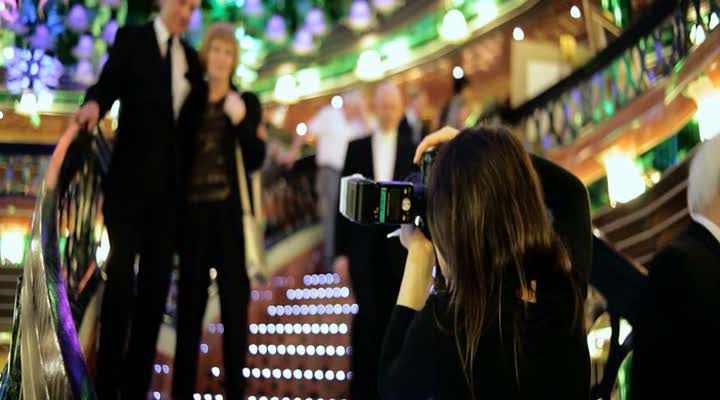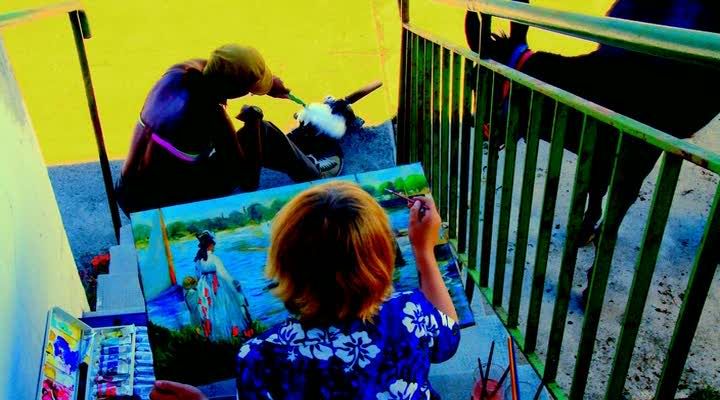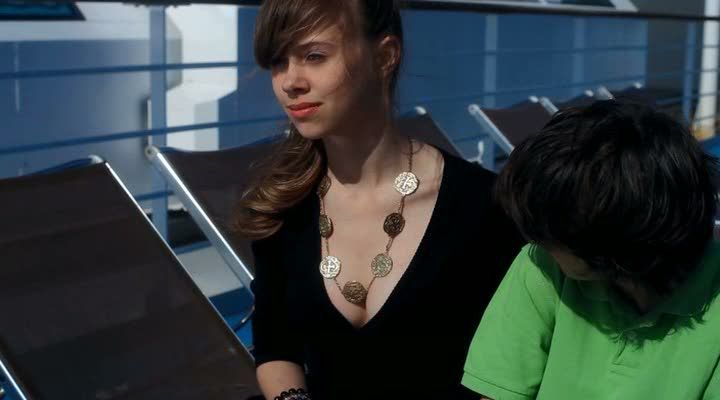
Take 1, because Film Socialisme is not a film that offers up its ideas easily, because Jean-Luc Godard, in his latest film and first feature since 2004's Notre musique, is typically opaque and elusive. Take 1, also, because Godard, trickster that he is, released this latest opus to the English-speaking world in a way deliberately designed to make it even more difficult for those who don't speak the film's many languages. The film's dialogue and monologues are in French, Russian, German, Arabic, and other languages, but only an occasional isolated phrase of English. And Godard's chosen subtitles are in what the director has playfully dubbed "Navajo English," minimalist strings of disconnected words, not so much translating the dialogue as providing snippets of meaning, hints at the full meaning of what's being said. The subtitles are less translations than messages to the audience, enigmatic epitaphs that translate not speech but the deeper subtexts of Godard's cinema. The subtitles are a kind of passive-aggressive joke on American audiences, because America and its influence is the film's subtext — for the most part, Godard avoids explicitly mentioning America so assiduously that it becomes the unspoken ghost within the film, the driving force for everything that happens, the hidden target of so many of the film's satirical jabs.
And what is this but a satire? A satire of America, of capitalism, and also of the whole idea of cinematic storytelling. The film is divided into three segments. The first is set on a cruise ship, visiting various locales that have resonance to Godard — Barcelona, Naples, Odessa, Hellas ("Hell As," and also hélas, as in "alas," as in Godard's Hélas pour moi), Egypt, Palestine ("Access Denied," the onscreen text simply reads at this last port of call) — and never venturing beyond the superficial surfaces of anything. The images are glossy and pristine, bright and beautiful, parodies of cinematic splendor that are both jaw-droppingly sublime and yet somehow empty, suggesting how little beauty counts for amidst all this silly opulence. The film is obsessed with gold, with money. The cruise passengers play slots, their mechanically pumping arms highlighted against a gorgeous seascape. A Christian mass is held in a dining room with a bar nearby and a crystal ball rotating overhead, projecting fragmented mirror images of the ceremony. Snatches of conversation, partially translated or not, are concerned with business deals, with history (Hitler, Stalin, Communism, wars civil or otherwise), with seeming plots and spy maneuvers.
This baffling, elliptical verbal chatter is juxtaposed against the images of the cruise ship's conspicuous consumption: dance clubs where the music is distorted into a noisy clamor, passengers watching workout videos and cinematic images of Arabs interchangeably, people lounging around, eating, staring out at the sea. What better place than a cruise ship for Godard to document the victory of capitalism and the death of socialism: it is a place where capitalism's virtue is assumed, where every image, every setting demonstrates the capitalist's ascendancy. To the extent that there are distinguishable characters in this section of the film, they are symbols and metaphors rather than actual individuals. So Godard pays special attention to the glowing glamor of this setting, but does so in ways that call attention to power relations and the subtexts of the capitalist system as it's incarnated here. One shot from early in the film shows a couple of passengers posing for a photo on a typically glitzy staircase, surrounded by bright lights. But the image is out-of-focus; only the photographer in the foreground, presumably a cruise ship employee, is in focus, while the rest of the image is deliberately blurred and indistinct, an abstract image of privilege and success rather than a concrete portrait of two particular people. The composition calls attention to the worker taking the picture rather than the photo's ostensible subjects.

The film's second section shifts to a rural setting and focuses more concretely on a single family. The fragmentary pacing and flashy aesthetics of the cruise ship segment give way to a slower, more patient pace and an emphasis on domesticity and routine. This family, the Martins, owns a gas station and is apparently involved in an important election. They are dogged by a pair of journalists with a movie camera, who hover around the gas station accosting anyone who walks by, trying to get interviews and images. The fragmentary dialogue of the film's first part is replaced by lengthier dialogues, which makes the incomplete "Navajo" translation more of an issue: during the cruise ship passage, the Navajo subtitles mirrored the jumpy editing and the collaging of hi-definition digital images with grainy video footage. Here, the subtitles really do feel like out-of-context fragments ripped out of a larger whole, and it becomes even more apparent that Godard intends for language-deficient Americans to understand only incompletely, to be denied the full meaning of the dialogues.
But this confrontational pose is balanced by moments of humor and playfulness, particularly in the form of the Martins' young blonde son, a sprite who incarnates Godard's still-youthful sense of humor. This boy, dressed in a red CCCP shirt decorated with the Soviet hammer and sickle, conducts the classical music of the soundtrack, wildly swinging a lead pipe through the air in response to the music. Later, in his sleep, the movements of his mouth and the twitch of his fingers respond to — or perhaps produce — the plucking bass of a jazz tune. This boy chases off the TV reporters with his pipe, swinging it like a sword, playing pirate. He feigns blindness and runs his hands along his mother's body, creating an image of her in his mind with his fingers. He paints a Renoir masterpiece, and Godard's camera looks over his shoulder, distorting the image with digital color manipulation, as the boy looks at the young black camerawoman in her bikini top but paints a Renoir scene of pastoral beauty. The manipulated, blown-out colors make the whole image look like a painting, artificial and distancing.

Godard seems to be suggesting that art distorts, art lies, art dodges reality: the disconnect between what the boy is looking at and what he's painting suggests that the art of the past, like Renoir's landscapes, is a way of avoiding engagement with the present, with what's directly in front of us. What we need is an art of the present, an art that engages with reality as it really is. Earlier, on the cruise ship, one of the wealthy passengers wound through a gallery crowded with paintings, all of them for sale, all of them representing a classical style from the past, and images from the past. The glorification of the past, the obsession with masterpieces and masters, is interwoven with commerce, with the value of art in terms of money. Godard's more interested in the present, in images that are aware of history but point towards people and things that are happening now. Thus the second section, with its emphasis on the slow rhythms of daily life — brushing one's teeth, reading a book, children playing, halting conversations between members of the family — locates Godard's ideas within the context of the family, the context of prosaic reality rather than the stylized confines of art.
In the film's final section, Godard adopts an essayistic style to return to the locales of the cruise ship's journey: Egypt, Palestine, Hellas, Naples, Barcelona. For the cruise ship, these were simply destinations, brief stopovers, their rich histories obscured by the tourist's gloss. Godard returns to them here by pulling images from newsreels and films, images of art and photographs of history mashed up alongside cinematic excerpts. He's examining the disjunctions between past and present, nowhere so obviously as when he cuts between the Odessa Steps sequence from Eisenstein and the modern-day Odessa Steps, a tourist attraction where groups of schoolchildren gather on the steps that were once the site of both a real massacre and its cinematic representation. It's during this section, especially, that Godard's insistence on denying meaning and translation render any understanding of the film conditional and ephemeral.

But, one suspects, that is the nature of the film in general, even for those rare individuals who "understand" all its many languages perfectly, who don't require any translation. Film Socialisme is dense and challenging, beautiful and provocative, allusive and elusive, bursting with so many ideas and suggestions that it defies the possibility of the kind of complete reading that one generally expects from a movie. In its very structure, the film is making a statement, more even than any Godard film before it, that the idea of complete understanding is an absurd joke.
Take 2, of perhaps many more, follows here. Understanding will come, if at all, much later.
"Understanding will come, if at all, much later."
ReplyDeleteAnd that's why I enjoy doing The Conversations with you.
Haven't seen this, but enjoyed reading about it. And sure appreciated that final though.
Actually i do not want to sound too eurocentric, but with this film (even more as with ELOGE and NOTRE MUSIQUE i think) its impossible to ignore its deep and actual very concret connection to post war (II) europen history. The Barcelona (demonstration) and Greek (democracy/tragedy) hints in the film are not even allegories - they are hard fact if you follow the recent "Euro-Issues" and i might even go so far as to say that JLG was/is again as "ahead/prophetic" as he was with LA CHINOISE regarding May 68.
ReplyDeleteI think linking the film to recent events gives it more "justice" as "just" seeing it as a methaphysical exegesis…
Also highly recommended (actually by JLG himself in an older ARTE interview, 2009 i think): http://www.amazon.com/Skin-European-Classics-Curzio-Malaparte/dp/0810115727/ref=sr_1_2?ie=UTF8&qid=1294064088&sr=8-2
Malaparte talks about the "The Pest" that came to Naples at the same time the allied troops (US) "libertaed" the city.
Thanks, Jason!
ReplyDeleteAccatone, that's a good point. Some of that came through more clearly for me on a second viewing (which I'll be posting about on Wednesday), but I still don't have enough knowledge of modern European affairs to follow all of Godard's references and the connections of the film to modern Euro politics. So I'm glad you brought that up. One of the great things about this film, and recent Godard in general, is that there's so much in it that everyone can bring their own frame of reference to the film and get something different out of it. I think it's fair to say that Godard was interested in both the concrete modern politics and the more metaphysical/philosophical strands that I was trying to tease out - and a lot more as well.
This is what I mean - it's going to take me a long time to feel like I fully understand this film, if I ever do. That challenge is why I keep returning to Godard, why there's really no other filmmaker whose films have so much to offer, so many angles to explore and depths to plumb.
You could start reading the Malaparte book - its very intense and adventures (also very brutal in its realistic descriptions of post war Naples). No doubt this has an allegoric approach in terms of "America effecting/infiltrating/imperialising Old Europe" - and no doubt it has some undertones that are not antisemitic (the american discussion about JLG on this topic is so absurd) but "sceptical" to say at least. (something Malaparte shares with JLG in my opinion is this sceptisisim). There is no entry for this book on American Wikipedia but only for the film (that is not recommended). In the Malaparte entry i found this:
ReplyDeleteAccording to D. Moore's editorial note, in The Skin:
Malaparte extends the great fresco of European society he began in Kaputt. There the scene was Eastern Europe, here it is Italy during the years from 1943 to 1945; instead of Germans, the invaders are the American armed forces. In all the literature that derives from the Second World War, there is no other book that so brilliantly or so woundingly present triumphant American innocence against the background of the European experience of destruction and moral collapse.
Excellent write-up Ed.
ReplyDeleteYou raise two shots I hadn't thought about that may be a key to better understanding: the focus being on the photographer rather than the photographed and what you say about the boy and his painting.
"Film Socialisme is dense and challenging, beautiful and provocative, allusive and elusive, bursting with so many ideas and suggestions that it defies the possibility of the kind of complete reading that one generally expects from a movie."
Precisely. It is for these reasons among others that I consider it the greatest film of the past year.
The film is perfect material for one of your 'conversations' (despite its relative obscurity), though you probably wouldn't finish it by next new year.
I wrote something on it myself here:
http://checkingonmysausages.blogspot.com/2010/10/film-socialisme-jean-luc-godard.html#comments
Accatone, that seems like a good recommendation and one I'm adding to my reading list. Thanks for that!
ReplyDeleteStephen, I'm reading your piece now, I'd avoided it until I saw the film myself. Great job parsing some of the ideas brought up by Godard. It's definitely my favorite film of the past year if only because nothing else I've seen even approaches it in terms of complexity and ambition, not to mention pure (audio)visual beauty.
Film Socialisme is the Absolute Masterpiece that Godard has been working towards for some time. No story, no characters, no stars (outside of brief guest star Patti Smith), very few professional actors (all of them bit players), and a great many actual people.
ReplyDeleteMost important of all almost no Godard. Or at least very little. The images that we see were shot partially by him, and partially by his cast -- who were given video cameras to shoot as they wished. Add "smaplings" from a host of other movies (among them Youssef Chahine's Adieu Bonaparte, Welles' Don Quixote and Jacques Tourneur's The Battle of Marathon) and you've got a cross between Vertov's The Man With the Movie Camera and Warren Sonbert's Carriage Trade
Plus something more, that I'm still trying to figure out.
Truly disgusting to see an NYT piece about Godard that blathers on about Breathless and Band of Outsiders but doesn't so much as MENTION Film Socialisme in passing!
The Los Angeles Film Critics Association has awarded Film Socialise its Douglas Edwards Independent/Experimental Film and Video award for 2010. When you're talking Independence and Experimenation nothing else come close.
We've invited J-L G to our awards dinner on the 15th but don't expect him to show up. Godard is now The Phantom of the Cinema -- the primary "structuring absence" of an art he elevated like few others living or dead.
BTW, if you go to the website "Pirate Bay" you can downloard Film Socialisme as an avi file for free.
ReplyDeleteNo Godard, and yet every frame seems to scream his name. He has a way of taking material that's not his and shaping it into something that could only come from him. That Sonbert comparison is a good one, David, as this is Godard's diary of observations and ideas, an assemblage of moments and images (borrowed or invented) rather than stories. The boat trip is Godard's version of all of Sonbert's images of planes, and views from plane windows.
ReplyDeleteThe NYT indifference to late Godard is nothing new - I well remember that Stephanie Zacharek piece that pissed me off so much a few years ago, again with that fixation on Breathless and disinterest in everything that came after it. Godard is difficult, no doubt, but it's still suprising and sad that so few are willing to make an effort with these films. Godard at 80 is bolder and more original than ever, and no one seems to care. They'd rather just see Anna Karina dance again, I guess.
I highly recommend everyone do as David suggests and download this film. It's not likely to get distributed anywhere, and in any event it demands to be watched and rewatched, to be paused and rewound, to be revisited, in a way that you can't do in the theater. The downloads are the best alternative until the DVD comes along, eventually.
Besides Warren's work Film Socialisme is a counterpoint to Manoel De Olieira's A Talking Picture which also concerns an ocean voyage. But the 102 year-old mastro had John Malkovich and Catherine Deneuve onboard in that one. One of many differences.
ReplyDeleteFantastic post, Ed. I was really hoping I'd get to read your thoughts on this one at some point. I had it as my #3 of the year behind Everyone Else and White Material, but quite honestly it could just as easily been #1 - it's the only movie I was compelled to watch three times this past year, and each viewing just bowled me over. It's certainly a beautiful, complex masterpiece, one that I feel almost becomes more elusive as you come to better know its images and sounds.
ReplyDeleteTwo things, Ed: Will your second viewing likewise be with the Navajo subs, or are you going to watch it with the proper English subs that have made their way online? Also, my favorite Navajo sub has got to be "Empire ortourism" Heh.
Thanks, Drew. I'm very excited by this film, and envision revisiting it many more times. I've already watched it a second time, and made sure to use the full English subtitles for that viewing. It makes a big difference. Watching it again with the full subtitles really underscored what a bold move it was for Godard to release the film with its language intentionally obscured for non-French-speaking viewers. A lot of things about it opened up for me on second viewing - though a lot more continued to confound! You're right, a certain amount of elusiveness is built into the film, and Godard's meta jokes about languages and words only add to the complexity of it all.
ReplyDeleteWhere cna you get full English subtitles?
ReplyDeleteDavid - Here is a link to the .srt file, it can be tacked onto the .avi (though it maybe out of sync w/the version on Piratebay, not sure of its source):
ReplyDeletehttp://0x2620.org/srt/film_socialisme.srt
also David, I don't know if you're already on Karagarga or not, but the version on there syncs perfectly with the above subs. If you're interested in an invite, feel free to email me @ tosh500@gmail.com
Check your e-mail.
ReplyDeleteIs that kid staring at that chick's tits in that last picture? Jean-Luc, you sly dog.
ReplyDeleteWhatever else Godard is — and he's lots of things — he's also an old lecher for sure. It's pretty funny.
ReplyDeleteEd,
ReplyDeleteI have the French DVD of the film which has Navajo subtitles - I'm pretty familiar with the text now (having downloaded full subtitles as a guide) and my French is good enough to work my way through it.
It looks great and it's a joy to look at it to my heart's content.
re the boy looking at the girl's chest - it's to do with the gold-looking necklace she's wearing (gold being a theme in the film). He reaches out to touch it later. I assumed they were brother and sister.
I look forward to the next part.
Thanks for the DVD info, Stephen. I'm still holding out hope for an eventual true English-friendly DVD that has both the Navajo subtitles and some fuller English translations. I can understand bits and pieces of French sometimes, but not enough that I'd want to rely entirely on Godard's prank subtitles.
ReplyDeleteAnyway, I think the boy and the girl are brother and sister, and that the gold necklace does tie into the frequent mentions of gold and money in this film, which doesn't mean that Godard is above leering at the girl's cleavage a bit in shots like that.
"I can understand bits and pieces of French sometimes, but not enough that I'd want to rely entirely on Godard's prank subtitles."
ReplyDeleteOh I'd like full subtitles on the film too. It's hard (though fun) enough piecing together all the allusions and meanings in the film without doing the same with the language.
"...which doesn't mean that Godard is above leering at the girl's cleavage a bit in shots like that."
You have a point there!
"The downloads are the best alternative until the DVD comes along, eventually."
ReplyDeleteEd, the DVD is already available at least in Europe. Check, for example, here:
http://www.amazon.fr/Film-Socialisme-Jean-Luc-Godard/dp/B003TP3VBI/ref=sr_1_1?ie=UTF8&qid=1294575927&sr=8-1
Nice post and blog!
Thanks, Susskind. I had heard about the French DVD, and it's definitely tempting, but as I mentioned above, for now I'm holding out for a DVD (likely in the UK?) that contains both the Navajo and full English subtitles.
ReplyDelete